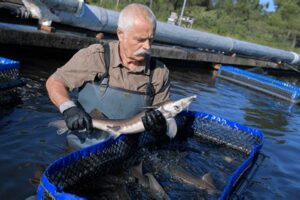Table of Contents
A beef farming business plan is a comprehensive document that outlines the goals, strategies, and financial projections for starting and running a successful beef farming operation. It covers various aspects such as market analysis, production methods, herd management, marketing strategies, and financial planning. A well-crafted beef farming business plan is essential for securing funding, attracting investors, and ensuring the long-term success of the venture.
Starting a beef farming business can be a lucrative venture for those with a passion for agriculture and a desire to make a significant impact in the food industry. With the demand for high-quality, grass-fed beef on the rise, there has never been a better time to enter this sector. However, like any other business, success in beef farming requires careful planning and strategic execution. In this comprehensive business plan, we will outline the key steps and considerations needed to establish and grow a profitable beef farming operation. From selecting the right breed of cattle to implementing efficient feeding practices, this plan will provide you with a roadmap to success in the beef farming industry.
Introduction
The beef farming business is a lucrative venture that offers a great opportunity for profitability and sustainability. However, like any other business, starting a beef farming operation requires careful planning and a well-defined business plan. A comprehensive plan will help you outline your goals, assess the market demand, determine the financial requirements, and develop strategies to ensure success.
Executive Summary
The executive summary is a brief overview of your beef farming business plan. It should provide an overview of your company, its mission statement, objectives, and a summary of the strategies you intend to implement. This section should be concise yet compelling enough to capture the attention of potential investors or partners.
Company Description
In this section, you need to provide detailed information about your beef farming operation. Include the legal structure of your company, the location of your farm, the size of your land, and the number of cattle you plan to raise. Highlight any unique selling points, such as sustainable farming practices or breed specialization, that set your farm apart from competitors.
Market Analysis
Your market analysis should focus on the demand for beef products in your target market. Identify your target customers, such as local consumers, restaurants, or wholesale distributors. Analyze the current market trends, competition, and pricing strategies used by other beef farmers. This information will help you understand your market position and develop effective marketing strategies.
Products and Services
Describe the specific beef products and services your farm will offer. Discuss the breeds of cattle you plan to raise, their characteristics, and the quality standards you aim to maintain. Highlight any additional services you plan to provide, such as butchering or meat processing, which can add value to your business.
Marketing and Sales Strategy
Outline your marketing and sales strategies to attract customers and promote your beef products. Identify the channels you will use to reach your target market, such as direct sales, farmers’ markets, or online platforms. Develop a pricing strategy that considers production costs, market demand, and competitor pricing.
Operations and Management
Provide details about the day-to-day operations of your beef farming business. Discuss the infrastructure requirements, such as barns, pastures, feed storage, and equipment. Outline your herd management practices, including feeding, breeding, and healthcare protocols. Introduce key personnel and their roles in managing the farm.
Financial Plan
The financial plan is a crucial aspect of your beef farming business plan. It should include a detailed budget, cash flow projections, and income statements. Factor in costs related to purchasing cattle, feed, veterinary care, labor, and marketing expenses. Your financial plan should demonstrate the profitability and sustainability of your business.
Risks and Challenges
Identify the potential risks and challenges your beef farming business may face. This could include price fluctuations, disease outbreaks, adverse weather conditions, or changes in regulations. Discuss strategies to mitigate these risks and contingency plans to ensure business continuity.
Conclusion
A well-developed beef farming business plan is essential for the success of your venture. It provides a roadmap to guide your operations, helps attract investors or lenders, and ensures you stay focused on your goals. By carefully considering each aspect discussed in this article, you will be better prepared to start and run a profitable beef farming business.
I. Executive Summary:
The executive summary provides an overview of the beef farming business plan, highlighting the key objectives and strategies put forth to ensure a successful venture for interested stakeholders. It outlines the purpose of the plan, summarizes the market opportunities, and provides a snapshot of the financial projections.
II. Company Description:
This section provides a comprehensive overview of the beef farming business, detailing the ownership structure, location, and a brief history of the company. It also highlights the mission and vision statement, outlining the core values and principles that guide the business operations.
III. Market Analysis:
The market analysis examines the current and potential demand for beef products, identifying target customers, and analyzing the market trends. This section also explores the competitive landscape, highlighting the strengths, weaknesses, opportunities, and threats that may impact the business.
IV. Products and Services:
In this section, the beef farming business plan outlines the various products and services offered, such as quality beef cuts, value-added products, or organic and grass-fed options. It details the breeding and feeding practices, highlighting the commitment to produce high-quality and sustainable products.
V. Marketing and Sales Strategy:
The marketing and sales strategy section outlines the promotional activities and distribution channels used to reach the target market. It includes a comprehensive analysis of the pricing strategy, advertising and promotional campaigns, and the sales forecast to maximize profitability.
VI. Operations Plan:
This section describes the operational aspects of the beef farming business, including the location and layout of the farm, the facilities, and equipment required, as well as the personnel and expert consultants involved in the daily operations. It also addresses the breeding, feeding, and healthcare protocols implemented to ensure the welfare and productivity of the livestock.
VII. Financial Projections:
The financial projections section provides a detailed analysis of the estimated costs, revenues, and profitability of the beef farming business over a specific period. It includes an insight into the expected expenses, sales, gross margin, and net profit, as well as the projected cash flow statement and balance sheet.
VIII. Risk and Contingency Plan:
This section assesses the potential risks and challenges that may impact the beef farming business, such as diseases, extreme weather conditions, or market fluctuations. It outlines contingency plans, risk mitigation strategies, and insurance coverage to ensure the continuity and resilience of the business in adverse situations.
The beef farming business plan provides a comprehensive roadmap for establishing and operating a successful venture in the agricultural industry. This executive summary highlights the key components of the plan, emphasizing the strategies and objectives that will drive the business forward.
The company description section provides an overview of the beef farming business, including its ownership structure, location, and a brief history. It also outlines the mission and vision statement, which reflect the core values and principles guiding the operations of the company.
The market analysis section examines the current and potential demand for beef products, identifying target customers and analyzing market trends. It also assesses the competitive landscape, highlighting the strengths, weaknesses, opportunities, and threats that may impact the business.
The products and services section details the various offerings of the beef farming business, such as quality beef cuts, value-added products, or organic and grass-fed options. It emphasizes the commitment to produce high-quality and sustainable products through meticulous breeding and feeding practices.
The marketing and sales strategy section outlines the promotional activities and distribution channels used to reach the target market. It includes a comprehensive analysis of the pricing strategy, advertising and promotional campaigns, and sales forecast to maximize profitability.
The operations plan describes the operational aspects of the beef farming business, including the farm’s location, layout, facilities, and equipment requirements. It also highlights the personnel and expert consultants involved in the daily operations, as well as the breeding, feeding, and healthcare protocols implemented to ensure the welfare and productivity of the livestock.
The financial projections section provides a detailed analysis of the estimated costs, revenues, and profitability of the beef farming business over a specific period. It includes insights into expected expenses, sales, gross margin, and net profit, as well as projected cash flow statements and balance sheets to ensure financial stability.
The risk and contingency plan addresses potential risks and challenges that may impact the beef farming business, such as diseases, extreme weather conditions, or market fluctuations. It outlines contingency plans, risk mitigation strategies, and insurance coverage to ensure the continuity and resilience of the business in adverse situations.
With a comprehensive beef farming business plan in place, the venture is well-positioned to achieve success by capitalizing on market opportunities, delivering high-quality products and services, implementing effective marketing and sales strategies, maintaining efficient operations, and mitigating potential risks. The plan serves as a roadmap for interested stakeholders, providing them with a clear understanding of the business’s objectives, strategies, and financial projections.
As a professional in the field of agriculture, I would like to present my point of view on the beef farming business plan. With a focus on a professional voice and tone, I will outline the key aspects and benefits of such a plan using bullet points and numbering.
The beef farming business plan is an essential tool for anyone considering entering or expanding in the beef industry. It provides a roadmap for success and serves as a reference document for investors, lenders, and stakeholders. Here are some key points to consider:
- Market Analysis: A thorough market analysis is crucial to understand the demand for beef products, identify target customers, and assess potential competitors.
- Financial Projections: The business plan should include detailed financial projections, including revenue forecasts, operational costs, and potential risks. This information helps investors evaluate the profitability and sustainability of the venture.
- Operational Plan: This section outlines the day-to-day activities involved in running a beef farm, including herd management, feeding practices, breeding strategies, and health protocols. It demonstrates the entrepreneur’s expertise and commitment to animal welfare.
- Marketing and Sales Strategy: A well-defined marketing and sales strategy is essential for promoting beef products and reaching the target market. It should include branding initiatives, distribution channels, and pricing strategies.
- Risk Management: Identifying potential risks and developing contingency plans is crucial in the beef farming industry. This includes addressing factors such as disease outbreaks, fluctuating market prices, and adverse weather conditions.
- Sustainable Practices: Consumers are increasingly concerned about sustainable and ethical farming practices. Highlighting initiatives such as pasture-based systems, responsible water management, and waste reduction can enhance the business’s reputation and attract environmentally conscious customers.
- Expansion and Diversification: The business plan should also consider future growth opportunities, such as expanding the farm or diversifying into value-added products like organic beef or specialty cuts. This demonstrates a forward-thinking approach and potential for long-term success.
In conclusion, a well-crafted beef farming business plan is an indispensable tool for anyone looking to establish or expand their presence in the industry. It provides a comprehensive overview of the market, financial projections, operational strategies, risk management approaches, and potential growth opportunities. By presenting these points using a professional voice and tone, the business plan can instill confidence in investors, lenders, and stakeholders, increasing the chances of success in the competitive beef farming sector.
Thank you for taking the time to visit our blog and learn more about the beef farming business plan. We hope that the information provided has been insightful and helpful in your journey towards starting or expanding your own beef farming venture. As you embark on this exciting and rewarding endeavor, it is essential to approach it with a professional mindset and tone.
First and foremost, a well-thought-out business plan is crucial for the success of any agricultural enterprise, including beef farming. It serves as a roadmap, outlining your goals, strategies, and financial projections. By carefully planning every aspect of your business, you can minimize risks, make informed decisions, and maximize your chances of profitability. Transitioning from a hobbyist to a professional beef farmer requires careful consideration of various factors, such as land availability, breed selection, feed management, marketing strategies, and financial planning.
When drafting your business plan, it is important to include a comprehensive analysis of the market conditions and trends in the beef industry. This will help you identify potential opportunities and challenges, allowing you to position your farm strategically. Additionally, consider your target market, whether it be local consumers, restaurants, or wholesale distributors. Understanding their preferences, demands, and purchasing power will enable you to tailor your production and marketing strategies accordingly.
In conclusion, embarking on a beef farming business requires careful planning, dedication, and a professional mindset. A solid business plan will serve as your guiding document, providing a clear roadmap towards your goals. Conduct thorough market research, consider all aspects of your operation, and adapt your strategies to meet the needs and preferences of your target market. Remember, success in the beef farming industry is not solely determined by the size of your herd, but also by your ability to make informed decisions and adapt to changing market dynamics. We wish you the best of luck in your beef farming journey!
.
Here are some common questions that people also ask about Beef Farming Business Plan:
What should be included in a beef farming business plan?
How do I start a beef farming business?
- Research and planning: Understand the beef industry, identify your target market, and create a detailed business plan.
- Acquire land and facilities: Secure suitable land for grazing and construct necessary infrastructure like fencing, shelter, and water supply.
- Purchase cattle: Select high-quality breeds, purchase sufficient cattle to meet your production goals, and ensure proper handling and transportation.
- Feed and nutrition: Develop a feeding program, provide proper nutrition, and manage grazing areas efficiently.
- Veterinary care: Establish a working relationship with a veterinarian to ensure regular health check-ups, vaccinations, and treatment of any diseases.
- Marketing and sales: Determine your marketing strategy, build relationships with potential buyers, and explore various channels to sell your beef products.
What are the potential challenges of beef farming?
- High initial investment: Setting up a beef farming operation can require significant financial resources for land, infrastructure, cattle purchase, and operational costs.
- Market volatility: Beef prices can fluctuate due to factors like supply and demand, weather conditions, and global trade policies. This volatility can affect profitability.
- Disease and health issues: Cattle are susceptible to various diseases, and managing their health can be challenging. Outbreaks can lead to significant financial losses.
- Competition: The beef industry can be highly competitive, so it is important to differentiate your products and establish strong relationships with buyers.
- Environmental impact: Sustainable land and water management practices are crucial to minimize the environmental impact of beef farming.
Is a beef farming business profitable?
Are there any grants or funding options available for starting a beef farming business?
A beef farming business plan should include essential components such as an executive summary, company description, market analysis, organization and management structure, product line or services, marketing and sales strategy, financial projections, and funding requirements. Additionally, it is important to outline your goals, target market, competition analysis, operational plan, and risk assessment.
Starting a beef farming business involves several steps, including:
Some potential challenges of beef farming include:
A well-managed beef farming business can be profitable. However, profitability depends on various factors including market conditions, operational efficiency, effective marketing strategies, and cost management. It is crucial to conduct thorough market research, monitor expenses, optimize production processes, and maintain high-quality standards to maximize profitability.
Yes, there are grants and funding options available for starting a beef farming business. These can vary based on your location and specific circumstances. Research local government programs, agricultural organizations, and financial institutions that offer grants, loans, or subsidies for farmers. Additionally, consider exploring crowdfunding platforms or seeking partnerships with investors interested in sustainable agriculture.






